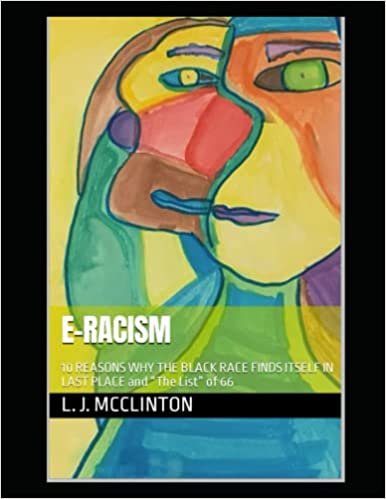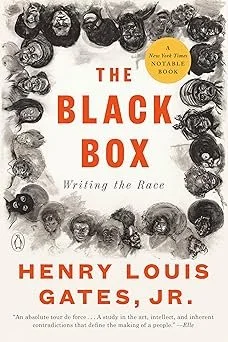 Image 1 of
Image 1 of


E- Racism: 10 REASONS WHY THE BLACK RACE FINDS ITSELF IN LAST PLACE... 2022
In the writing of this series and two books simultaneously; I’ve read, studied and selected nuggets of wisdom and statistics that were invaluable in painting a complete picture of the state of the Black race in America. Once chosen and incorporated they were molded as 10 Reasons and “The List.” The list is comprised of 66 different statistics that I began to compile in the course of research. It reflects what I thought would be only a few items that Black Americans struggled with in terms of quality-of-life issues. However, around every corner the bad news kept coming. Because I was following breaking and ongoing reporting of violent crimes that escalated here in Chicago and some of the most outstanding became part of this narrative. It seemed only natural to add what might be extenuating circumstances for the level of violence that predated the COVID-19 pandemic. One common thread emerged: concentrated poverty, segregated situations among Blacks who were left behind in the ghetto. Or who may have relocated to a new still segregated ghetto. There was another common thread that locked in the poverty and isolation: most of the incarcerated, for example, were dropouts or received a poor education and were also most likely to be “single-race” blacks. I found, and statistics bore out this observation, that blacks with the darkest of skin and the most African of features were most likely to become isolated in failing schools and ghettoized with others like themselves. They were “rejected” by more successful and middle-class blacks and the larger society.
Some may find the reading too negative or depressing. Relatives and friends have turned away from watching the news and news about violent crime in Chicago. The old "perp walk" was gone, but it has returned. It's a mistake to ignore or reject the negative news about black America. Knowledge is still power and can save your life. However, I had this sentiment when salient characteristics of black culture were glossed over or omitted in the narrative by black media, academics and progressives. This rejection of good news about black Americans is slowly changing. It's not enough to fill commercial ads with black or Asian faces when we know minorities are still a minor part of the entertainment and advertising pie. Progress, upward mobility and health and wealth has not found every American. I've concentrated on what's missing for black Americans to close the gap of nearly every measure identified.
In the writing of this series and two books simultaneously; I’ve read, studied and selected nuggets of wisdom and statistics that were invaluable in painting a complete picture of the state of the Black race in America. Once chosen and incorporated they were molded as 10 Reasons and “The List.” The list is comprised of 66 different statistics that I began to compile in the course of research. It reflects what I thought would be only a few items that Black Americans struggled with in terms of quality-of-life issues. However, around every corner the bad news kept coming. Because I was following breaking and ongoing reporting of violent crimes that escalated here in Chicago and some of the most outstanding became part of this narrative. It seemed only natural to add what might be extenuating circumstances for the level of violence that predated the COVID-19 pandemic. One common thread emerged: concentrated poverty, segregated situations among Blacks who were left behind in the ghetto. Or who may have relocated to a new still segregated ghetto. There was another common thread that locked in the poverty and isolation: most of the incarcerated, for example, were dropouts or received a poor education and were also most likely to be “single-race” blacks. I found, and statistics bore out this observation, that blacks with the darkest of skin and the most African of features were most likely to become isolated in failing schools and ghettoized with others like themselves. They were “rejected” by more successful and middle-class blacks and the larger society.
Some may find the reading too negative or depressing. Relatives and friends have turned away from watching the news and news about violent crime in Chicago. The old "perp walk" was gone, but it has returned. It's a mistake to ignore or reject the negative news about black America. Knowledge is still power and can save your life. However, I had this sentiment when salient characteristics of black culture were glossed over or omitted in the narrative by black media, academics and progressives. This rejection of good news about black Americans is slowly changing. It's not enough to fill commercial ads with black or Asian faces when we know minorities are still a minor part of the entertainment and advertising pie. Progress, upward mobility and health and wealth has not found every American. I've concentrated on what's missing for black Americans to close the gap of nearly every measure identified.
In the writing of this series and two books simultaneously; I’ve read, studied and selected nuggets of wisdom and statistics that were invaluable in painting a complete picture of the state of the Black race in America. Once chosen and incorporated they were molded as 10 Reasons and “The List.” The list is comprised of 66 different statistics that I began to compile in the course of research. It reflects what I thought would be only a few items that Black Americans struggled with in terms of quality-of-life issues. However, around every corner the bad news kept coming. Because I was following breaking and ongoing reporting of violent crimes that escalated here in Chicago and some of the most outstanding became part of this narrative. It seemed only natural to add what might be extenuating circumstances for the level of violence that predated the COVID-19 pandemic. One common thread emerged: concentrated poverty, segregated situations among Blacks who were left behind in the ghetto. Or who may have relocated to a new still segregated ghetto. There was another common thread that locked in the poverty and isolation: most of the incarcerated, for example, were dropouts or received a poor education and were also most likely to be “single-race” blacks. I found, and statistics bore out this observation, that blacks with the darkest of skin and the most African of features were most likely to become isolated in failing schools and ghettoized with others like themselves. They were “rejected” by more successful and middle-class blacks and the larger society.
Some may find the reading too negative or depressing. Relatives and friends have turned away from watching the news and news about violent crime in Chicago. The old "perp walk" was gone, but it has returned. It's a mistake to ignore or reject the negative news about black America. Knowledge is still power and can save your life. However, I had this sentiment when salient characteristics of black culture were glossed over or omitted in the narrative by black media, academics and progressives. This rejection of good news about black Americans is slowly changing. It's not enough to fill commercial ads with black or Asian faces when we know minorities are still a minor part of the entertainment and advertising pie. Progress, upward mobility and health and wealth has not found every American. I've concentrated on what's missing for black Americans to close the gap of nearly every measure identified.
Publisher : SP (August 14, 2022)
Author: L. J. McClinton
Paperback : 256 pages
ISBN-13 : 979-8840360316




